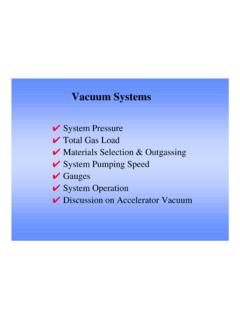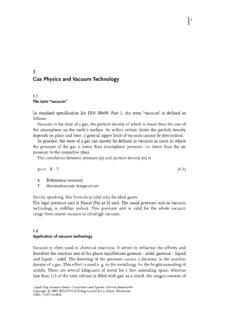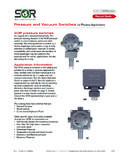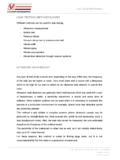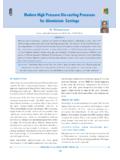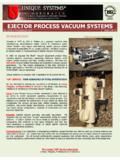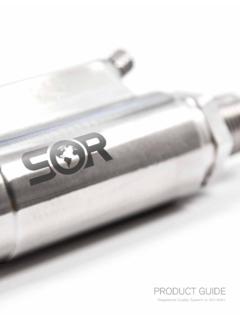Transcription of CLEANING FOR VACUUM SERVICE - vacuumcursus.nl
1 CLEANING FOR VACUUM ReidCLRC Daresbury Laboratory, Warrington WA4 4AD, UKAbstractThis paper will discuss the background to choosing an appropriate cleaningprocess for a VACUUM vessel or component dependent on the pressureregime required. Examples of CLEANING techniques and processes will begiven and ways of determining whether or not an item is sufficiently cleanwill be INTRODUCTIONE xperience shows that in order to achieve all but the most modest levels of VACUUM it is necessary toclean VACUUM vessels and components in some way. This is because as far as VACUUM is concerned,the world is a dirty place! In general, vessels and components will have been machined, worked insome way or another, or handled. Such processes may use greases or oils which have high outgassingrates or vapour pressures and which will remain on or in the surface.
2 Marking pens and adhesivetapes leave residues on surfaces which can also enhance outgassing. Water, solvents and other liquidscan remain embedded in cracks or pores in a surface and can outgas over long periods. All suchcontamination can limit the base pressures attainable in a general terms as far as VACUUM is concerned, we define contamination as anything which prevents the VACUUM system from reaching the desired base pressure introduces an unwanted or detrimental species into the residual gas modifies the surface properties of all or part of the VACUUM system in an undesired wayThus for example, a pool of liquid mercury in a VACUUM system will, at room temperature, limitthe base pressure to about 2x10-3 mbar, its vapour pressure. If the system were required to operate at,say, 10-5 mbar, the mercury would be a an electron storage ring, the cross section for electrons scattering off a residual gas moleculeincreases as the square of the atomic number, Z, of the scattering species.
3 Thus, for long beamlifetimes ( low electron losses), it is important to minimise the partial pressures of high-Z specieswhich are contaminants in the residual a system operating at 10-8 mbar, the partial pressure of hydrocarbons might be 10-11 hydrocarbon molecules striking a mirror surface can crack or polymerise when irradiated byelectrons or photons, leading to maybe graphite-like overlayers or to insulating layers. A completemonolayer might form in about 12 days, assuming that 1 in every 10 molecules impinging on thesurface is cracked and sticks. The optical properties of the mirror are therefore altered by the surfacebecoming there is a necessity to clean to remove actual or potential contaminants. We will define asuitable CLEANING process as one which results in the residual VACUUM being suitable for the task.
4 Thisdefinition is heavily influenced by the observation that most people who use VACUUM are notinterested in VACUUM as such but are interested in an industrial process (semiconductor chipproduction or metal refining for example) or a scientific experiment (such as studying chemicalcatalytic reactions on a surface) or operating a machine (maybe a particle accelerator). What they areinterested in is having a defined, controlled atmosphere and VACUUM is just the simplest way ofachieving this discussion, we shall be considering in very general terms some of the factors influencingthe choice of a CLEANING process. This article is an overview and does not pretend to be acomprehensive review citing the literature in detail. A (very) short and selective bibliography is givenat the end and interested parties can use the references in these papers as a starting point for a more indepth CHOOSING A CLEANING PROCESST here is no one CLEANING process which is right for all VACUUM systems, vessels or of the things which will need to be taken into account are as follows the level of VACUUM required (rough, high, UHV, etc) if there is a particular performance requirement ( low desorption) whether there is a particular contaminant ( hydrocarbons)
5 Whose partial pressuremust be minimised what materials the items are made from how the items are constructed safety costOnce these have been considered, and we will look at some of these in more detail below, then onecan begin to choose a CLEANING agent and the necessary processes to achieve the desired is important to realise that there are very many different recipes in the literature and in thefolklore of VACUUM . Advocates of a particular process or procedure will defend their choice with analmost religious fervour. Generally, this is because the procedure works for them, it meets theirrequirements. Often this procedure will not have been tested rigorously against other possibleprocedures which might be equally good if not better (in some sense) and will therefore in no wayhave been optimised. This is not necessarily a problem.
6 It often simply means that the processes beingused may not be as economical or convenient as they might be. Whether this is important or notdepends on the individual this article, we will look briefly at both chemical and physical CLEANING processes. There are,however, some general points which should be taken into account when deciding what to use. Someof these are as follows. Some CLEANING processes which are often used are applied more for cosmetic purposesto make VACUUM chambers look clean by producing mirror finish surfaces and so from a VACUUM point of view they are actually cleaner is by no means to betaken for granted. Such surfaces could, for example, exhibit enhanced outgassing. The minimum chemical CLEANING process compatible with the level ofvacuum/cleanliness required should always be chosen.
7 The less that needs to be done to avacuum surface the better. Chemical CLEANING is a hazardous procedure so must be done safely! Processes such as bead or shot blasting, grinding, scraping and mechanical polishing canleave dirt trapped in voids in the surface of materials which can then be very difficult toremove. Acid treatments such as pickling, passivation or electropolishing can trap acids in thesurface of the material. For demanding UHV applications, a VACUUM bake to 450oC isrequired to remove these DEPENDENCE ON THE BASE PRESSURE REQUIREDIn general the lower the base pressure required, the more rigorous the CLEANING process will need tobe. (Note that in general it is preferable to use the term base pressure rather than ultimatepressure which is commonly used. Base pressure refers to the lowest normal pressure attained in avacuum system in its working condition, whereas ultimate pressure strictly refers to the lowestpressure obtained in a standard defined system measured in a standard way.)
8 Fig 1 illustrates in a very schematic fashion some typical common CLEANING processes whichwould be used in sequence. To use this figure, select the approximate pressure required and thenapply all the processes in order from the top to the level corresponding to the pressure 1: Simple CLEANING procedures4. DEPENDENCE ON CONTAMINANTSThe user will have to determine what level of contaminants can be tolerated in any given process. It isimportant to distinguish between the total pressure required in the system and the partial pressures ofparticular species which can be allowed. As has been said, most processes use VACUUM simplybecause it provides an easily controlled environment for the process and it is really what can andcannot be tolerated in that environment which is any given process, the user may have to determine by tests what CLEANING is necessary toobtain the desired has been discussed above, one very common requirement is to reduce hydrocarboncontamination to a minimum.
9 This will often best be achieved by washing in a hot organic solventsuch as trichloroethylene or perchloroethylene (where use of these substances, both chlorinatedhydrocarbons, is permitted) followed by washing in hot clean demineralised water and a general CLEANING recipe that works in many circumstances is given in Section HOW CONSTRUCTION AFFECTS CLEANINGIn order to clean a VACUUM component to the highest standards - capable of working at UHV withvery low levels of contaminant species in the residual VACUUM - at the design stage carefulconsideration must be given to how the item is to be cleaned. In particular, crevices, blind holes,cracks, trapped volumes, etc., should be avoided as these will act as dirt and solvent traps. It can bevery difficult to remove both dirt and solvent from such areas.
10 Fortunately, good VACUUM practiceregarding trapped volumes will also result in a component which avoids these good design working at lower VACUUM levels will also seek to remove any such component which must be cleaned with particular care is thin-walled edge-welded bellowsoften used for motions in VACUUM . Care must be taken that the CLEANING process does not causeparticles to be left in the convolutions, since these can puncture the bellows when it is degreasers can be particularly prone to this as they often throw precipitates. During CLEANING ,the bellows should be fully extended and a careful final wash with demineralised water and a blowdry with hot compressed air, both inside and out, must be the process uses chlorinated hydrocarbon solvents then these must be removed completely byheating, as any left behind can corrode the bellows, leading to leaks.

